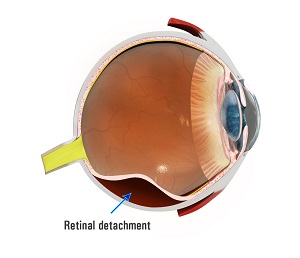
What is Retinal Detachment?
Retinal Detachment is an eye disorder in which the retina (light receptive layer of tissue at the back of the eye) is pulled away from its normal position. In retinal detachment, the retina gets separated from the underlying choroid (layer of blood vessels that supplies oxygen and nutrients to the retina) and leaves the retinal cells deprived of oxygen. Certain risk factors, such as aging, severe near-sightedness, eye injury, cataract surgery, and family history, can increase the chances of retinal detachment. If not treated early, this condition can cause permanent vision loss.
Symptoms of Retinal Detachment
Certain symptoms appear as warning signs and almost always appear before retinal detachment can occur or become more severe. The characteristic signs and symptoms that indicate the onset of retinal detachment include:
- Sudden onset of blurred vision
- Partial vision loss (as if a gray curtain is moving across the field of vision)
- Eye floaters (tiny specks or strings floating in the field of vision)
- Eye flashes (the illusion of flashing lights in the side vision)
- Shadows or blind spots (areas of darkness) in the field of vision
Depending on the cause, three types of retinal detachment are observed:
Rhegmatogenous retinal detachment (RRD): This is the most common type of retinal detachment and is associated with a hole or tear in the retina. Fluid from the vitreous humor (jelly-like center of the eye) seeps through the retinal hole and accumulates in the space between the retina and the underlying retinal pigment epithelium (RPE), thereby lifting the retina. RPE, located between the retina and the choroid layer, is a pigmented cell layer that nourishes the retinal cells.
Tractional retinal detachment (TRD): It is the second most common type of retinal detachment. TRD occurs due to the formation of scar tissue or growth of other abnormal tissue on the surface of the retina, separating the retina from the underlying RPE. TRD is commonly observed in people with uncontrolled diabetes, previous retinal surgery, or chronic inflammation.
Exudative retinal detachment: This type occurs when blood or fluid from the choroid leaks into the space between the retina and the underlying RPE, causing a detachment. This is an uncommon complication of conditions such as hypertension, eye tumors, and rare blood vessel disorders.
To diagnose retinal detachment, a comprehensive eye examination is performed; wherein the physical appearance of your eye, vision, eye pressure and your ability to see colors is tested. Your doctor instills eye drops to dilate your pupil in order to see your retina properly. An ultrasound may also be ordered in certain cases.
Treatment for Retinal Detachment
There are several methods to treat retinal detachment. These include:
- Scleral bulking
- Sutureless vitrectomy
- Tamponade
- Silicone oil
- C3F8/SF6
- Complicated Retinal Detachment (PVR, TRD)
- Vitrectomy for Retinal Detachment
- Treatment for Retinal Detachment
Related Topics
- Retinal Detachment
- Retinal Tear
- Diabetic Retinopathy
- Age-Related Macular Degeneration
- Retinal Vascular Diseases
- Retinal Artery Occlusion
- Retinal Vein Occlusion
- Retinal Hemorrhage
- Vitreous Hemorrhage of any Etiology
- Central Serous Retinopathy
- Posterior Vitreous Detachment
- Vitreomacular Traction Syndrome
- Epiretinal Membrane
- Macular Edema
- Macular Hole
- Retinoschisis
- Ocular Ischemic Syndrome
- Cystoid Macular edema
- Color Blindness
- Nyctalopia/Night Blindness
- Cone Dystrophy
- Choroideremia
- Retinopathy of Prematurity
- Uveitis & Ocular Inflammation
- Retinoblastoma

